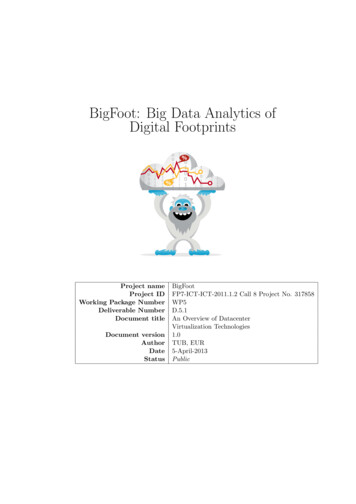
Transcription
BigFoot: Big Data Analytics ofDigital FootprintsProject nameProject IDWorking Package NumberDeliverable NumberDocument titleDocument versionAuthorDateStatusBigFootFP7-ICT-ICT-2011.1.2 Call 8 Project No. 317858WP5D.5.1An Overview of DatacenterVirtualization Technologies1.0TUB, EUR5-April-2013Public
Deliverable D.5.1BIGFOOTVersion 1.0Revision .603/04/’13 0.704/04/’13 1.0DescriptionInitial Deliverable SetupOutlined definedWork on general backgroundWork on BigFoot research linesDocument ReviewWork on Virtualization and CloudComputingWork on Introduction and ConclusionDocument 11.1.2 Call 8 Project No. 3178582
Deliverable D.5.1BIGFOOTVersion 1.0Executive summaryThis deliverable is released after the first six months of the EU projectBigFoot, and is related to the first phase ”Design and Specification” of thework package WP5.In this deliverable we present a survey on current practices and techniques that have been proposed to virtualize computation and networkingin a datacenter environment. We start with a categorization of datacenterstoday. We then show how virtualization has become a key enabler of multitenancy and cloud computing in datacenters. We also highlight the manyoptions that are now offered to virtualize networks and servers in the widenetwork and distributed datacenter environment. We conclude by sketchingpromising research directions and elaborating on how the BigFoot approachcan address a number of them.FP7-ICT-ICT-2011.1.2 Call 8 Project No. 3178583
Deliverable D.5.1BIGFOOTVersion 1.0Contents1 Introduction2 Datacenter Types2.1 Availability Requirements . . . . . .2.2 Operation and Deployment Models .2.2.1 Private Datacenters . . . . .2.2.2 Public Datacenters . . . . . .2.2.3 Distributed Datacenters . . .2.3 Tenancy in terms of Infrastructure .2.3.1 Co-location . . . . . . . . . .2.3.2 Dedicated Infrastructure . . .2.3.3 Shared Infrastructure . . . .2.4 Tenancy in terms of Application Mix2.4.1 Single-purpose . . . . . . . .2.4.2 Multi-purpose . . . . . . . . .5.3 Virtualization as an Enabler of Multi-tenancy3.1 Compute Virtualization . . . . . . . . . . . . .3.1.1 Server Virtualization . . . . . . . . . . .3.1.2 Migration . . . . . . . . . . . . . . . . .3.1.3 I/O Virtualization . . . . . . . . . . . .3.2 Network Virtualization . . . . . . . . . . . . . .3.2.1 Software-defined Networking . . . . . .3.2.2 Virtual Networks . . . . . . . . . . . . .6677788899101112.13131314151617184 Virtualization as an Enabler of Cloud Computing204.1 Infrastructure as a Service . . . . . . . . . . . . . . . . . . . . 204.2 Platform as a Service . . . . . . . . . . . . . . . . . . . . . . . 204.3 Software as a Service . . . . . . . . . . . . . . . . . . . . . . . 205 Open Issues and BigFoot5.1 Beyond Best-effort Services . . . . . . . . . . . . .5.1.1 Towards Application-aware VM Placement5.1.2 Software Switch Performance . . . . . . . .5.2 Performance Evaluation of Cloud Services . . . . .5.2.1 Performance Interference . . . . . . . . . .5.2.2 Virtual Network Topologies . . . . . . . . .6 ConclusionFP7-ICT-ICT-2011.1.2 Call 8 Project No. 317858.22222425262728304
Deliverable D.5.11BIGFOOTVersion 1.0IntroductionEnabled by the successful application of the virtualization design principle,Cloud computing revolutionized and continues to transform industry andour society: Computation (and software) has nowadays become a commodity; Internet services can be deployed cheaply without large hardware investments, or costs for human operation Cloud computing also solves the problem of efficiently provisioning fora service with uncertain popularity, by making it possible to adapt thedeployed application capacity on-demandAn extensive overview of the benefits outlined above can be found in [26,56, 47, 94, 93].The advent of arbitrarily scalable and elastic resources at low cost is attractive for various services, ranging from time-critical big data analytics tonew proximity-aware and latency-critical applications. Such services can bedeployed on public or private clouds both spanning one or more datacenters.Public cloud are based on the pay-as-you-go principle and mainly consistsin utility computing; private clouds, instead, live within the premises of andauthoritative domain of a single organization.The purpose of this document is to provide an overview of the literatureand state-of-the-art solutions in the area of large-scale distributed computing in virtualized contexts such as the private and public clouds. A mainemphasis will be on the existing hardware architectures as well as the abilityto scale resources elastically.The remainder of this document is organized as follows. Section 2overviews the different types of datacenters that exist today. Section 3 isdedicated to a general overview on how datacenter resources can be sharedamong multiple tenants. Section 4 focuses on the role of virtualization as akey enabler for cloud computing.A particular emphasis is also put on the networking part, as it constitutesa major subject of investigation in the BigFoot project. Section 5 is based onthe general literature surveyed before and discusses additional recent worksthat are closely related to the vision we have in BigFoot. In particular, wediscuss a number of relevant open issues that we will study during the courseof the project. We here focus on an experimental and measurement-basedapproach on prototype private clouds we develop in BigFoot.FP7-ICT-ICT-2011.1.2 Call 8 Project No. 3178585
Deliverable D.5.12BIGFOOTVersion 1.0Datacenter TypesDepending on business needs, there is a long spectrum of datacenter types.In this section, we present a basic classification of datacenters with respectto requirements such as availability, operation and deployment models andapproach to multi-tenancy.2.1Availability RequirementsDatacenters may have a wide range of availability requirements. Availabilityof a service is driven by the criticality of the services that are being providedthrough it. The Uptime Institute [18] defines multiple tiers for datacentersite availability on the dimensions of: downtime per-year, redundancy inthe distribution path for power and cooling, as well as susceptibility todisruptions from planned and unplanned activities. We now describe thetiers.Tier I - Basic Site Infrastructure: the site has non-redundant powerand cooling components, as well as a single, non-redundant distributionpath. The site is susceptible to planned and unplanned disruptions throughoperational errors by administrators, or outages of the capacity componentsor distribution path. The site has to offer 99.671% availability (downtimeof 28.8 hours per year).Tier II - Redundant Site Infrastructure Capacity Components:the site has redundant capacity components (power and cooling), but onlya single distribution path. This implies that bringing down distributionpath components for maintenance would cause a disruption of the serviceshosted on the datacenters servers. The site has to offer 99.741% availability(downtime of 22.0 hours per year).Tier III - Concurrently Maintainable Site Infrastructure: thesite has redundant capacity components. There are multiple distributionpaths: one active and one in standby. The improved redundancy allowsconducting planned maintenance without disrupting services. However, unplanned events will still cause disruption. The site has to offer 99.982%availability (downtime of 1.6 hours per year).Tier IV - Fault Tolerant Site Infrastructure: the site has redundant capacity components and multiple, simultaneously active distributionpaths. This increases fault tolerance of the site in light of component failures, distribution path failures, or planned maintenance. The site has tooffer 99.995% availability (downtime of 0.4 hours per year).FP7-ICT-ICT-2011.1.2 Call 8 Project No. 3178586
Deliverable D.5.12.2BIGFOOTVersion 1.0Operation and Deployment ModelsDepending on the business use-case, there are multiple operation and deployment models for datacenters today:2.2.1Private DatacentersPrivate datacenters are purpose-built datacenters for the specific needs ofa corporation. The infrastructure is thus operated and used by the sameorganization, within the same authoritative domain: nevertheless, multipletenants (e.g., different teams, departments or projects) may be granted cloudresources.These datacenters often serve to accommodate a mix of development andproduction deployments of storage and compute platforms. Much of theexisting literature has focused on optimizing different layers, in particulardatacenter networking: [24, 50, 51, 61, 25, 78, 77, 33, 62, 34, 49, 104].The increasing popularity of data-intensive open-source applications (e.g.Hadoop [6]) to perform data analytics, is driving the deployment of privatedatacenters. Prime operators of such datacenters are financial companies,large corporations, web service providers, just to name a few. The exact number of such datacenters is unknown, but likely to be significant.Furthermore, a large number of scientific computational clusters and datacenters hosted in universities and research centers also contributes to theknown1 infrastructure.2.2.2Public DatacentersDatacenters are also deployed to satisfy local as well as global markets. Arough estimation of the currently operated small to medium size datacenters accounts more than 2280 datacenters in around 84 countries [7] andmost of them offer servers, storage and network resources for lease. Manyof them offer dedicated or virtualized servers, or both. Typical services thatare offered are Web hosting and storage. For example, Softlayer has morethan 191.5K servers in 7 datacenters [99], OVH has more than 120K serversand more than 3.5K cloud servers [82], 1&1 has more than 70K servers in 5datacenters [20], Leaseweb has more than 50K servers in 6 datacenters [69]and Rackspace has more than 190K customers in 8 datacenters [89]. By farthe most successful story in leasing virtualized resources using the public1In the sense that details on the architecture are publicly availableFP7-ICT-ICT-2011.1.2 Call 8 Project No. 3178587
Deliverable D.5.1BIGFOOTVersion 1.0cloud is Amazon Web Services (AWS) [95]. Amazon maintains 7 large datacenters and caches in at least 25 locations around the world for its CDNsolutions, CloudFront. In 2009 AWS operated only 40K servers and by theend of 2012 the number of servers is estimated to exceed 400K [76].2.2.3Distributed DatacentersDespite the economies of scale that a centralized datacenter offers, there is anincreasing trend to build datacenters and interconnect them. Apart from theabove-mentioned distributed datacenters, Content Distribution Networks(CDNs) are massively distributed infrastructures [70] continuously deployedto cope with volatile and increasing demand for content, which needs tobe replicated and made accessible from different locations in the Internet[58, 101, 23]. Some CDNs place their servers deep inside the network whereasothers that provide good connectivity to eyeball networks use also InternetExchange Points (IXPs) [22]. Akamai operates more than 120,000 servers inmore than 2,000 locations across nearly 1,150 ISP networks [81, 3]. Akamaiutilizes a number of techniques to improve content delivery and applicationacceleration [70]. These techniques include: assembly of pages on the fly andat the edge, prefetching, compression and delta encoding, and monitoringof the state of the network and path diversity, to name a few. Google isreported to operate tens of datacenters and front-end server clusters worldwide [64, 100, 10]. Microsoft has deployed its CDN infrastructure in 24locations around the world [29]. Limelight operates thousands of servers inmore than 22 delivery centers and connects directly to 600 networks worldwide [79]. Distributed datacenters are also used for delivering bulk data overthen Internet [68].2.3Tenancy in terms of InfrastructureThe cost of deploying, maintaining, managing and replacing infrastructureis high [47]. To that end, different management solutions have been appliedto better allocate infrastructure resources, from fully dedicated to shared.2.3.1Co-locationCo-location is a term coined to describe the hosting of infrastructure off-site:it emerged from the need to install and operate hardware, including routersand frontend servers, in multiple and diverse geographical and network-wiselocations. Large companies have evolved, such as Equinix [8] that is locatedin 95 points and 15 countries around the globe. IXPs [22] also facilitateFP7-ICT-ICT-2011.1.2 Call 8 Project No. 3178588
Deliverable D.5.1BIGFOOTVersion 1.0co-location centers — today, there are more than 320 IXPs [9] deployedin major cities. Co-location centers typically offer the choice of leasinghardware, placing hardware, as well as leasing slices of shared resources.2.3.2Dedicated InfrastructureFor many applications such as video streaming the full utilization of thecomputational, storage and network resources are needed. Today, a largefraction of the Internet traffic is due to video [59, 66, 46, 43]. To cope withthis demand, large online Video providers such as YouTube and Netflix havedeveloped their own datacenters or rely on large CDNs [21]. Moreover, suchlarge content providers deploy their own servers inside consumer ISPs toreduce inter-domain traffic and to improve end-user performance. Googlehas launched Google Global Cache [11, 28], partnering with ISPs to optimize network costs associated with Google traffic, especially video trafficfrom YouTube. Netflix, being currently responsible for more than 30% ofthe traffic in North America [59], has introduced Open Connect CDN [13]with similar goals. Both Google Global Cache and Netflix Open Connectappliances are located inside ISPs or, alternatively, in interconnection andpeering points.2.3.3Shared InfrastructureVery recently, a number of large network operators published a white paperto describe their view on network function virtualization [19]. Network function virtualization constitutes a paradigm shift of deploying service-specificappliances inside the network to transform it into an open and genericusage appliance; such services include message routers, carrier-grade NATs(Network Address Translation), broadband remote access server (BRAS),deep-packet inspection systems, firewalls, load balancers, to name a fewexamples.Such generic appliances are physically built out of standard high volumeservers, storage and Ethernet switches. Independent software vendors caninstall their applications in these generic appliances, located deep inside thenetwork or in datacenters. This setting leads to a win-win situation to different parties that are involved in the deployment and operation of serverinfrastructure [83, 84, 85]. For example, Akamai recently announced theformation of content delivery strategic alliances with major ISPs, namelyAT&T [1], Orange [2] and Swisscom [16]. Such alliances allow, for example, both CDNs and ISPs operators to jointly deploy server infrastructuresFP7-ICT-ICT-2011.1.2 Call 8 Project No. 3178589
Deliverable D.5.1BIGFOOTVersion 1.0within the network to reduce cost, improve end-user experience, improvetraffic engineering. Such deployment can use bare metal solutions or takeadvantage of virtualization.The management of computation, storage and network components, inaddition to the task of orchestrating the deployment of virtual machines(VMs) on top of physical servers is today possible through “cloud-managementsystems”. The default interface that is currently advocated by many projectsis Openstack [14], which is supported by a number of vendors and software houses. OpenStack is is also widely used in virtualized datacenters.In addition, there are solutions tailored to generic appliance provision andmanagement such as SCC [74].Theoretical results have also shown that sharing of computation and network resources can be done in an online fashion in wide area networks [113] aswell as in datacenters [63]. Last but not least, recent studies have also shownthat outsourcing service functionality can significantly reduce the operational cost of enterprises without significantly sacrificing performance [96].2.4Tenancy in terms of Application MixBenson et al. [32] present a detailed study of network traffic characteristics ofuniversities, enterprises and cloud datacenters. It highlights important differences between utilization of these datacenters with regards to the kind ofapplications being used, traffic patterns and link-utilization at different layers of the topology. Two of the datacenters that were surveyed were singlepurpose cloud datacenters whereas the others were multi-purpose enterprise and campus datacenters. We now describe characteristics observed bythe authors that are relevant for this survey.Non-uniformity of application placement: Different datacentershave very different mixes of applications running in them, with placementof applications across different physical servers being non-uniform. Thisleads to non-uniform traffic combinations being observed across differentswitches in the datacenter. This heterogeneity would be inherently moreprevalent in virtualized and hosted environments due to a larger number ofhosted applications.Multiple inter-dependent components: In all datacenters that weresurveyed, there was either a mix of inter-dependent applications or components within a single application that was distributed. For instance, in thesurveyed university and enterprise datacenters, traffic to authentication services from web-portals were observed. The university datacenters also had aheavy traffic share attributed to the distributed file systems in use. In threeFP7-ICT-ICT-2011.1.2 Call 8 Project No. 31785810
Deliverable D.5.1BIGFOOTVersion 1.0of the cloud datacenters that were surveyed, the applications being run weretypically composed of multiple applications with intricate dependencies, deployed across the datacenter. An example of such an interaction is that ofa social networking web-site’s frontend requiring access to authenticationservices for verifying users and different sets of data-stores for aggregatingdifferent kinds of data. Two of the cloud datacenters were dedicated torunning MapReduce jobs.Network communication patterns: Two of the cloud datacentersthat were surveyed were used primarily for running MapReduce jobs, whilethe other three hosted a mix of customer-facing applications and the backends to support them. In all these cases, the authors observed a high degreeof intra-rack traffic with at least 75% of traffic confined to the rack in whichit was generated. This is attributed to co-location of inter-dependent applications. However, in the case of the private and educational datacentersthat were surveyed, at least 50% of the traffic generated at the servers wasobserved to leave the rack. A possible reason for this is poor co-location ofdependent applications. The communication patterns in the cloud datacenters also displayed time-of-day and week-of-day traffic patterns.Flow level patterns: The authors observe that for the private andeducational datacenters that were surveyed: 1) the number of active flowsper-switch in any given second is at most 10,000; 2) new flows may arrivewithin 10µs of each other; 3) most flows were small in size (less than 10KB),of which, a significant fraction are only a few hundreds of milliseconds long;4) traffic leaving the edge switches are bursty in nature with ON/OFF intervals following a heavy tailed distribution; 5) The predominant applicationi
Deliverable D.5.1 BIGFOOT Version 1.0 1 Introduction Enabled by the successful application of the virtualization design principle, Cloud computing revolutionized and continues to transform industry and our society: Computation (and software) has nowadays become a commodity; In











